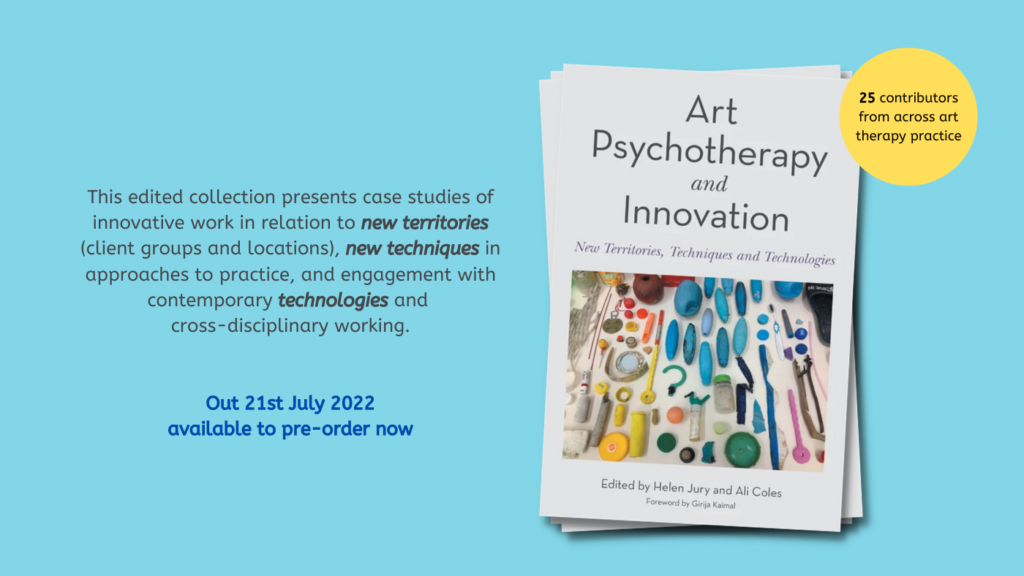New ways of working: Art Psychotherapy and Innovation in a post-pandemic world
Blog post written by Ali Coles and Helen Jury: Co-editors of Art Psychotherapy and Innovation

‘When this book was first envisaged, we did not know how changed the world would be by the time of publication. The art psychotherapy profession now works in a different domain, governed and shaped for the future by worldwide pandemic experience, in which the adaptability and creativity of the arts therapies have come to the fore in response to demonstrated need and demand. Art Psychotherapy and Innovation: New Territories, Techniques and Technologies showcases the ongoing versatility and adaptability of the profession internationally, constituting vigorous evidence for originality in theory and practice that continues to emerge in art psychotherapy as a robust and resilient profession, and one which often incorporates creative and pioneering thinking ‘outside the box’.’
(Introduction, Art Psychotherapy and Innovation: New Territories, Techniques and Technologies)
Co-editor, Helen Jury:
Having lived, trained and worked in Latin America, Europe and the UK, I feel passionate about thinking in a culturally diverse and interdisciplinary manner, incorporating acquired skills and an understanding of cultural values in my art and Art Psychotherapy practices. Art Psychotherapy is an expanding and versatile profession, demonstrated by the international range in Art Psychotherapy and Innovation: New Territories, Techniques and Technologies, which showcases original and culturally diverse new practice and theoretical ideas. The present moment feels an important juncture for such a publication, in times of uncertainty, social and political upheaval, and financial insecurity worldwide. We live in an altered and politically complex world post-pandemic with mental health issues on the rise, but also with increased value, appreciation and diversity of creative expression and its contribution to wellbeing and health. The versatility in Art Psychotherapy practice and theoretical understanding demonstrated in the book allows the profession to develop clinically, adding a solid evidence base as contribution to research in the field of the psychological therapies. There is a continuum of creative and original thought and practice in the Art Psychotherapy profession, and the fraction showcased in this collection of chapters explores some of the exciting research taking place internationally in concepts, cultural perspectives and technological advances, as well as societal changes taking place as a result of Covid.
Co-editor Ali Coles:
One of the things that attracted me to train as an art psychotherapist, later in life, was the creativity which is inherent within the approach – not just the art process which is at the centre of the practice, but also the way in which art psychotherapists creatively adapt their approaches to meet the needs of those they serve. It is this creative mindset which allows innovation to flourish. Often, like me, art psychotherapists have previously worked in other fields, and can use these skills and interests to develop their therapeutic practice. For example, I have a background in museum work and have developed ways of using museum objects to aid the therapeutic process within art psychotherapy sessions for adults with mental health difficulties. Museum-based art therapy is now a growing area of innovation, as evidenced in our previous co-edited book which is also published by Jessica Kingsley: ‘Art Therapy in Museums and Galleries’ (2020). My chapter in Art Psychotherapy and Innovation: New Territories, Techniques and Technologies is co-authored by Neil Winter, who has experienced art psychotherapy as a client. He considers that the central position of art within art psychotherapy means that this type of therapy can be a particularly creative, responsive and innovative one, and urges the profession to keep hold of a culture of artistry and innovation amidst all the pressures that we face. It is this creativity that allows art psychotherapists to imagine new ways of working or new ways of conceptualising art psychotherapy practice. Creative thinking also enables art psychotherapists to work across disciplinary boundaries and resist the constraints of professional ‘silos’. Every chapter in this book exemplifies the open, flexible, reflective and responsive stance of art psychotherapists, across a huge range of client groups, professional contexts and geographical locations, and it has been an inspiring process to work with Helen to put the book together.
Art Psychotherapy and Innovation: New Territories, Techniques and Technologies is published by Jessica Kingsley Publishers. Pub date: 21st July 2022. Available to pre-order now.
Art Therapy in Museums and Galleries’ is also published by Jessica Kingsley Publishers. Available to order now.
Like what you read? We have more exclusive blog posts, videos, author interviews and exclusive offers when you join our mailing list.